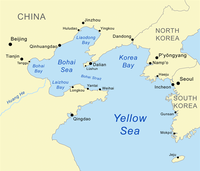
Photo from wikipedia
The species composition and biomass of phytoplankton, as well as hydrological characteristics, were estimated during four spatial surveys in the Subarctic tidal Kem’ River estuary and adjacent area of Onega… Click to show full abstract
The species composition and biomass of phytoplankton, as well as hydrological characteristics, were estimated during four spatial surveys in the Subarctic tidal Kem’ River estuary and adjacent area of Onega Bay (White Sea, Russia) in June–July 2008–2011. The study area was divided into the zones (river, transition, and marine), based on salinity variation of the surface water layer. In total, 318 species of phytoplankton were recorded, 143 species were found in the river zone, 225 in the transition zone, and 106 in the marine zone. Diatoms were represented by the greatest number of species in all zones. The highest phytoplankton biodiversity in the surface layer was found in the transition zone. The averages of total phytoplankton biomass in the surface layer (B0) in different years varied as 2.8–16.9 mgC/m3. Although B0 did not differ significantly between zones (except 2011, when B0 was the highest in the river zone), the dissimilarity in the phytoplankton community structure in the river, transition and marine zones was 61–95%. The similarity of phytoplankton at stations of each zone was poor (22–53%); the lowest values were observed in the transition zone. It is postulated that the tidal cycle determines the spatial and temporal heterogeneity of the phytoplankton composition, structure, and abundance in the Kem’ River estuary in summer.
Journal Title: Oceanology
Year Published: 2019
Link to full text (if available)
Share on Social Media: Sign Up to like & get
recommendations!